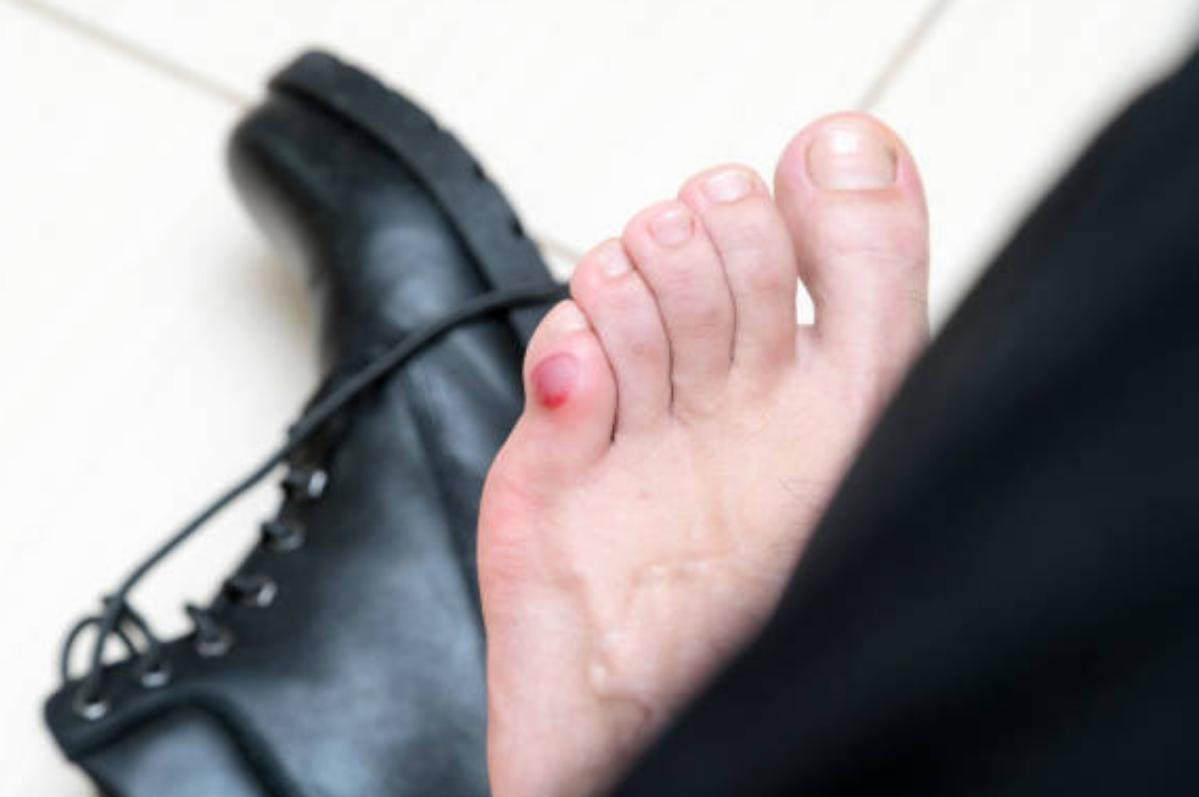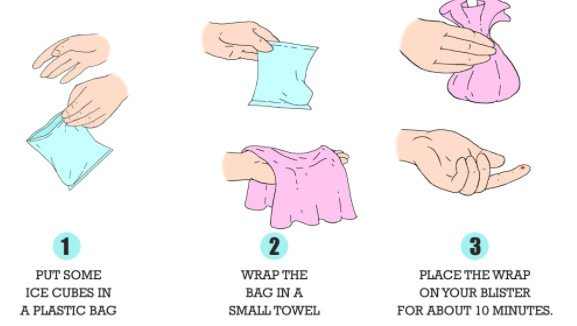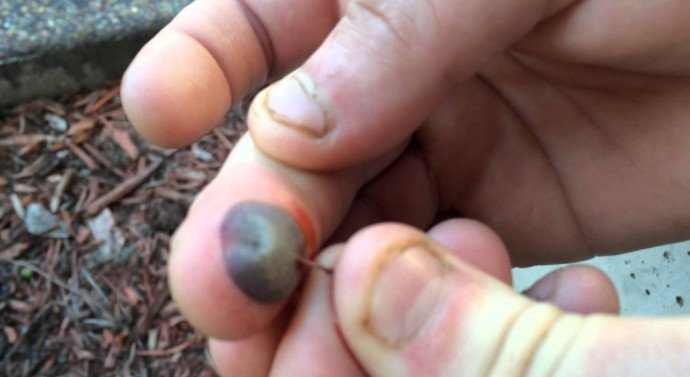Blood Blisters are small pockets of fluids that usually form in the upper layer of the skin has been damaged. These bumps form when there is a separation in the upper layer of the skin. Though common in hands and feet, blood blisters can develop anywhere on the body. The formation of blisters is a protective mechanism. After an injury or a burn, the blister will protect the underlying tissues from further damage and allow it to heal.
Here is an insight on how to pop a blood blister easily at home. We have also provided more information on the causes, symptoms, cure, and what you need to do and not do to a blood blister on any part of the body.
What causes a blood blister
A blood blister is simply a raised piece of skin that has blood inside. Blood blisters are not different from pus-filled blisters. Depending on what the underlying cause of the blisters is, there are considered harmless and will often go away within a week or two.
What causes blood blisters? As mentioned, Blisters are small pockets of fluids that form when the upper layer of the skin has been damaged. What that means is that a blood blister can form anywhere on the body. It can form on hands, necks, feet, just to name some.
In most of the cases, a new blood blister will generally appear red and, over time, turn a deeper shade. Common causes of blood blisters include simple accidents that pinch the skin but do not break the surface.
The common cause of blood blister will include:
- Performing activities such as dancing or running
- Wearing ill-fitting shoes for long is a common cause of blister on feet and toes.
- On hands, blood blisters can be as a result of using tools that rub against your skin.
Apart from physical causes, some conditions might lead to the formation of blood blisters. Some of the conditions include the following:
- Chickenpox a viral infection that causes red itchy spots on the skin
- Bullous impetigo a very contagious bacterial skin infection
- Cold sores also known as fever blisters
- Genital herpes and STI that commonly affect the groin
- Scabies, a skin condition caused by tiny mites
Symptoms of a blood blister
The symptoms of a blood blister are the same as that of a friction blister. Whereas friction blisters are filled with a clear fluid, blood blisters are filled with blood. In the formation of a blood blister, the pressure forming the blister breaks blood vessels. The blood from these vessels will mix with the clear fluid to form the contents of the blood blister.
Unless infected, a blood blister is often not a cause for concern. For friction blisters or those that form when your skin is pinched, no treatment is required. However, if a blood blister shows the following symptoms, then urgent treatment required. See your doctor if a blood blister on any part of the boy shows any of the following:
- The blister shows signs of an infection such as warmth, red lines that lead away from the blister
- You are unable to perform normal activities like walking, talking or holding things
- The blood blister forms for no reason
- You keep getting more and more blood blisters
- The blisters appear on sensitive places like inside the mouth or the eyeball
- When the underlying cause is an unidentified allergic reaction (this can be life-threatening)
Should you pop a blood blister?
Blood blisters are not life-threatening; neither are they a cause for concern. So NO, you should not pop blood blisters. Blisters should be left to heal on their own. Unless an underlying medical condition causes them, you should let the blister heal on its own.
Unless you have a weak or compromised immune system, a blood blister will often heal within a week or two. They can be painful while they heal bit there is no need to see a doctor or pop them.
You can easily relieve the pain caused by a blister by using an ice pack or a bag of frozen vegetables wrapped in a towel. To protect the blister and prevent picking up an infection, your need to do the following:
- Cover blood blisters that are likely to burst or pop. You can do this using a soft plaster or dressing
- Thoroughly wash your hand before touching a burst blister
- For a burst blood blister, allow the content to drain before covering it with a plaster
- Do not pop or burst a blister yourself
- Do not peel or remove the skin of a burst blister
- For a blister on feet, do not wear the shoe that caused the blister until the blood blister completely heals
Preventing blood blisters
Blood blisters can be painful and annoying to have. The national health services the UK says there are several things you can do to avoid getting blisters caused by friction, sunburn or chemical exposure and reaction.
According to NHS, you can do the following to prevent getting blood blisters:
- You need to wear comfortable, well-fitting shoes to prevent blisters on legs and toes
- Wear protective gear when building or dealing with reactive or corrosive chemicals.
- Before heading out, make sure to apply some sunscreen
- During exercises, you can prevent getting a blood blister by wearing thicker wool socks
- For those with sweaty feet, dust talcum powder in your socks
How to pop a blood blister at home
How do you pop a blood blister? Though most dermatologists advise against squeezing a blood blister, some people get very uncomfortable with the blister such that they cannot resist the urge to pop and drain it.
Beauty editor, a newspaper magazine, reports that there are some benefits for popping and squeezing these kinds of bumps on the skin. Some of the benefits of draining the contents of a blister are said to include the following:
- Speeds up the healing process of the blister
- Draining the blister also reduces the size of the blister
- Makes it easy to cover up the bumps
- When the blister is drained properly, it helps prevent scarring
Though popping a blood blister can have some advantages, it surely does not lack lots of disadvantages. You are discouraged from popping a blood blister because:
- It causes the blister to heal slowly
- It increases the risk of picking up an infection, bacterial or viral
- For an infected blood blister, popping increase the risk of spreading the infection to other parts of the body
- When a blood blister is not drained properly, it could lead to weeping, bruising and scarring
How then do you know a blood blister is ready for you to pop it? A ready blister is one with a soft covering. For a friction blister, the head of the bum will be red, which means the pus or content of the blister is closer to the surface. In such cases, you can pop the blister with little effort. DO NOT poop a blind blister. They feel hard and can be painful to touch.
Here is the right way to pop a blood blister at home.
- Clean your hands with soap and warm water then dry them with a clean towel
- Now gently clean the skin around the blister. Use warm which will help soften the blood blister
- The next thinning you need to do is sterilize the tool you will be using. Disinfect the needle by gently passing t through a flame. Allow it some time to cool then wipe down with alcohol.
- Now sterilize the blood blister by dabbing some alcohol on the blister and around it
- Pierce the bump to create a small tear from which the blood, pus and other content of a pimple can drain through
- Gently push down on the sides of the blood blister to get the blood and pus out. When doing this, you need to be wearing gloves or covering your index finger in a piercing of tissue.
- Don’t remove the skin covering the blister. Now dab some alcohol and apply drying lotion. Allow it some time to heal.
After popping a blood blister, you need to carefully monitor any signs of an infection. Once you develop an infection after popping a blood blister, your health care provider may prescribe oral antibiotics to treat the infection.
After popping or draining a blister, it is essential to clean and dress the blister well to reduce the chance of suffering an infection.
After popping a blood blister, an infection can be shown by the following signs and symptoms:
- A general feeling of unwell with fever and high temperatures
- Increased pain, swelling, and redness around the site of the blister
- Red streaks extending from the blister
- Pus and other fluids draining from the blister
Pictures of a blood blister
Here is how a blood blister looks like.

How to treat a blood blister
For healthy people, blood blisters will heal naturally within a week or two. There no treatment is required to treat the blisters. For people with weak or compromised immunes system; however, bursting the blister may lead to infection, this slows down the healing process.
Urgent treatment for a blood blister is required if:
- The blood blister is infected, as such, it is filled with yellow or green pus
- The blister appears in an unusual place such as on eyelids or inside the mouth
- The blisters are very painful
- Keeps coming back
- Or when the cause of the blister is a severe sunburn or an allergic reaction.
When a blood blister is infected, your dermatologist or general healthcare provider will prescribe antibiotics to treat the infection and speed up the healing process of the blister.
When the cause of the blister is a medical condition such as herpes, impetigo, or chickenpox, then treating the blisters will involve treating that specific underlying medical cause.
The National Health Services recommends that for a blood blister, it should be left to heal naturally. If the blister bursts, you need to keep the area clean and dry. Cover it with a sterile bandage to protect it from getting infected.
At home you can do the following to treat a blood blister:
- Cover the blister: this helps keep the skin over the blood blister intact. Covering the blister provides a barrier between the wound under your skin and the bacteria swirling around the blister. For less painful blister on fingers or the skin, you can cover with an adhesive bandage.
- Unless the pain is severe, do not pop the blister. This is a big no, especially for people with existing conditions such as diabetes, or other conditions causing poor blood circulation. If the blister is keeping you from performing some duties such as using your hands and legs, you can puncture it with care or have a professional health care provider assist in getting rid of it.
- Finally, you can carefully drain the blood and other contents of the blister by squeezing around it. This can be very painful, and most people are unable to do it correctly. If you cannot withstand the pain, please have the blister removed by a professional healthcare provider. Leaving it open can lead to an infection. This makes the wound even more painful.
How to get rid of blood blisters
A blood blister, as said, is often not harmful unless infected. As such, several options can be employed to treat and get rid of a blood blister. For a fresh blood blister, there are some effective natural remedies you can use to relieve the pain, soothe the irritation, and get rid of the blood blister.
Here are some of the effective home remedies you can use to get rid of a blood blister at home.
1. Garlic oil
Garlic oil is one of the most effective remedies you can use to relieve a drained blood blister. It is rich in natural minerals that speed up the healing process of a blister and acts as a disinfectant.
We recommend 100% Pure & Natural Garlic Essential Oil from Artizen (Check price on Amazon)
To reap the benefits of the oil, simply massage a considerable amount of the oil on a blister, leave it on for some minutes then rinse with cold water after some minutes. You will have to repeat this twice or thrice a day.
2. Cold compress
Applying a cold compress is the first thing you want to do after getting a blood blister. Applying a cold or ice compress on a fresh blood blister makes your blood vessel to constrict; this reduces swelling and stops the internal bleeding.

What you need to do is:
- Put some ice cubes in a plastic bag
- Wrap the bag in a small towel and
- Place the wrap on the blister for about 10 minutes
- Do not leave the ice on your skin for so long
3. Aloe Vera gel
Aloe Vera is a great anti-inflammatory remedy. It is also said to have a cooling effect thus may help relieve pain.
All you need to do is simply apply the gel over the blood blister twice or thrice in a day to reap the benefits of aloe Vera.
Our favorite one is organic cold-pressed Aloe Vera gel (Check price on Amazon)
4. Witch hazel
Witch hazel is another great remedy you can use at home to get rid of a blood blister. This remedy contains tannins that help dry the blood blister and reduce pain and inflammation. Witch hazel also helps speed up the healing of a blood blister by making them dry out.
5. Tea tree oil
The other great natural remedy you can try at home is tea tree oil. This remedy is said to contain a lot of medicinal properties that work well when treating a blood blister. Tea tree oil is said to be antiseptic, antifungal, and anti-inflammatory.
With these properties, tea oil works by naturally drying a blood blister. This is a painless way of getting rid of a blood blister anywhere on the body.
6. Epsom salt
At home, you can also get rid of a blood blister by soaking the blister in a mixture of lukewarm water and Epsom salt.
Applying this mixture to a blood blister helps burst the blister naturally. This will help reduce pain, swelling, or inflammation accompanying the blood blister.
What you need to do is,
- add a tablespoon of Epsom salt in some warm water,
- soak a clean face towel or cotton ball in the mixture
- clean the blood blister two to three times a day for some days
References
- Blood blisters on finger: http://www.healthmeds.org/blisters/blood-blister-finger-causes-treatment/
- How to treat a blood blister: https://healdove.com/disease-illness/Subungual-Hematoma
- Symptoms and treatment of a blood blister: http://www.healthline.com/health/blood-blister#overview1
- The dos and don’ts of a blood blister: https://www.blisterprevention.com.au/blister-blog/blood-blisters
- Treating a blood blister: http://www.nhs.uk/Conditions/Blisters/Pages/Treatment.aspx


